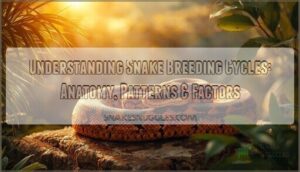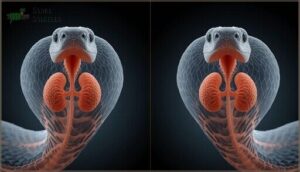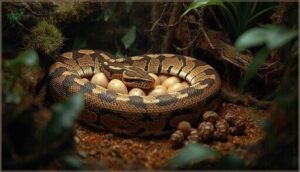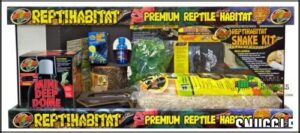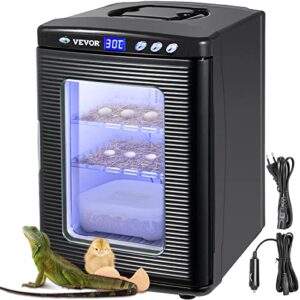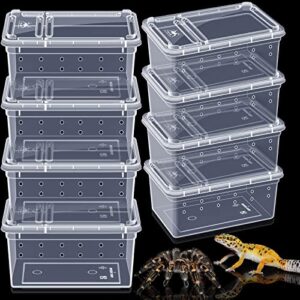This site is supported by our readers. We may earn a commission, at no cost to you, if you purchase through links.
A single shift in daylight or a subtle drop in temperature can set an entire snake population in motion. Breeding cycles in snakes don’t follow a simple calendar—they’re a complex dance, shaped by anatomy, climate, and the hidden rhythms of the wild.
If you’ve ever wondered why some females lay eggs while others give birth to live young, or how a snake’s body gets ready for the season ahead, understanding snake breeding cycles reveals a world of adaptation and strategy.
Mastering these patterns gives you the keys to successful breeding, healthier animals, and a deeper appreciation for their striking biology.
Table Of Contents
Key Takeaways
- Snake breeding success depends on mastering environmental triggers like temperature thresholds (15°C+ post-hibernation for mating, 75-92°F for egg incubation) and humidity control, since even small climate missteps can stall embryonic development or cause deformities.
- Female snakes need substantial body condition and energy reserves before reproduction begins—body fat thresholds directly control hormonal activation and sexual receptivity, making pre-breeding feeding schedules (3-5 times weekly with varied prey) critical for successful outcomes.
- Reproductive methods vary dramatically across species, with 70% being egg-layers (oviparity) and others giving live birth through viviparity or ovoviviparity, each requiring different management approaches for gestation periods that range from 9 weeks to occasionally 12 months.
- Breeding cycles follow annual, biennial, or triennial patterns tied to hibernation duration (females need 16+ weeks for complete ovarian development), with males using pheromone communication and combat rituals to compete for mates during narrow seasonal windows.
Snake Reproductive Anatomy and Methods
If you want to breed snakes successfully, you need to understand how their reproductive systems actually work. Male and female snakes have unique anatomical structures that drive their breeding capabilities, and knowing the difference between egg-laying and live-bearing species changes everything about your approach.
Let’s break down the key reproductive anatomy and methods that determine when, how, and why your snakes breed.
Male and Female Reproductive Organs
You’ll find that male snakes have paired testes near the kidneys, producing sperm continuously. They use hemipenes—inverted organs in the tail with ridges and grooves that assist sperm transfer during mating.
Female snakes possess paired ovaries and complex oviductal anatomy with specialized regions for egg formation and sperm storage.
The cloaca in both sexes serves reproductive, digestive, and excretory functions, making it central to snake reproductive anatomy. Some species exhibit a seasonal kidney enlargement linked to reproduction.
Oviparity, Viviparity, and Ovoviviparity
Now that you know the hardware, let’s talk about how snakes actually deliver offspring. About 70% are egg-laying snakes (oviparity), depositing clutches in warm, protected spots. Live-bearing snakes split between viviparity—where embryos get placental-like nourishment—and ovoviviparity, combining internal incubation with yolk-only nutrition. Several species, like the death adder, give birth to live young.
Here’s the breakdown:
- Oviparity: External eggs, no maternal investment post-laying
- Viviparity: Internal development with direct maternal nourishment
- Ovoviviparity: Eggs hatch internally before live birth
- Climatic adaptation: Live birth suits harsher environments
Internal Fertilization and Egg Development
Once mating wraps up, internal fertilization kicks off inside the female’s oviducts—often sealed by a copulatory plug to limit competition. She can store sperm for weeks or even months, timing egg development with perfect conditions.
From fertilization through embryo development and egg incubation, temperature drives everything. Oviparity, viviparity, and ovoviviparity all hinge on this controlled start, unlocking adaptive benefits across climates.
Parthenogenesis in Snakes
While most snakes reproduce sexually, some females can produce offspring without a male—a process called parthenogenesis. This asexual reproduction occurs in species like boas, pythons, and even pitvipers.
Offspring generally show reduced genetic diversity, often appearing as half-clones. Though rare, these reproductive strategies offer evolutionary advantages when mates aren’t available, reshaping how you approach conservation implications and research advancements in captive breeding programs.
Snake Breeding Cycles Explained
Understanding when and how often snakes breed isn’t just academic—it’s essential knowledge if you’re planning to work with these animals. Different species follow distinct reproductive timelines, from annual breeders to those that reproduce every few years, and these patterns tie directly to hibernation cycles and environmental cues.
Let’s break down the key breeding patterns, seasonal triggers, and behaviors that shape snake reproduction.
Annual, Biennial, and Triennial Breeding Patterns
You’ll encounter three main breeding cycles when raising snakes: annual, biennial, and triennial patterns. Annual breeders reproduce yearly when conditions favor consistent energetic costs, while biennial cycles occur every two years as females recover body condition. Triennial breeding—spanning three years—appears in populations facing environmental stressors or high population density.
Traditional studies often overestimate annual breeding frequency without catchability correction, so understanding these reproductive cycles helps you anticipate breeding windows accurately.
Mating Seasons and Hibernation Links
When temperatures climb past 15°C after hibernation ends, you’ll witness breeding season kick into high gear—this emergence synchronization drives intense post-hibernation aggression as males compete for receptive females. Temperature thresholds and physiological mechanisms govern these mating behaviors, directly linking environmental conditions to reproductive success.
- Male courtship intensifies between 10-25°C, optimizing fertilization rates
- Females require 16+ weeks of hibernation for complete ovarian development
- Climate implications affect timing, with warmer periods enabling earlier breeding cycles
Gestation Periods and Egg Laying Timelines
After successful spring mating, you’ll track dramatically different timelines depending on whether your species is oviparous or viviparous. Gestation periods span 9 weeks in northwestern garters to unusual 12-month stretches in northern copperheads. Gestation Length Factors include temperature, body condition, and Sperm Storage Impact, allowing delayed fertilization.
Egglaying snakes deposit clutches 40-90 days post-mating, with Egg Incubation Duration and Clutch size varying by species. Live Birth Variations in viviparous types show 3-5 month gestations, with Rare Gestations rarely extending years.
Courtship Rituals and Mating Behaviors
Once spring arrives, you’ll witness males using pheromone communication to track receptive females through tongue-flicking. Courtship rituals in snakes involve chin-rubbing, body crawling, and tail-waving before copulation begins.
Male combat determines breeding rights in polygynous species, while mating aggregations create competitive “mating balls” with multiple suitors.
Species variation shows unique behaviors—rattlesnakes wrestle without fangs, while some males employ coercive tactics to induce female receptivity during mating behavior in snakes.
Factors Influencing Snake Breeding Success
You can control every aspect of your snake breeding setup, but success ultimately depends on factors you can’t always see. Temperature swings, feeding schedules, and even the age of your breeding pair create a complex puzzle that determines whether you’ll get healthy offspring or disappointing results.
Let’s break down the four major influences that separate successful breeders from those who struggle season after season.
Temperature, Climate, and Environmental Conditions
Climate change effects hit snake breeding harder than most people realize. Your breeding program’s success depends almost entirely on environmental conditions—get temperature and humidity wrong, and you’ll watch embryonic development rates stall or crash completely.
Snake breeding success hinges on precise temperature and humidity—climate missteps can halt or ruin embryonic development entirely
- Egg incubation demands stable temps between 75°F and 92°F; anything outside this window causes deformities or death
- Thermoregulatory behaviors like basking help viviparous females buffer temperature swings during gestation
- Reproductive phenology shifts with local temperature cycles, directly controlling when and how often your snakes breed
Food Availability and Body Condition
Your snakes won’t breed if they’re running on empty—it’s that simple. Food availability and body condition control everything from breeding energy reserves to hormonal reproductive link activation. You’ll notice females need substantial reserves before reproduction begins; without meeting critical body fat thresholds, estradiol levels stay flat, and sexual receptivity never kicks in.
Feed your breeding females 3-5 times weekly with smaller, digestible meals every 2-3 days. This approach builds the caloric reserves necessary for successful reproduction without triggering regurgitation stress. Captive feeding regimens using varied prey—rodents, poultry, amphibians—mimic natural prey abundance impact and support body condition.
| Feeding Factor | Impact on Breeding |
|---|---|
| Pre-breeding feeding frequency | Females fed 3-5x weekly build sufficient energy reserves |
| Meal size and interval | Small meals every 2-3 days prevent stress while maintaining readiness |
| Body condition threshold | Below-threshold females show no sexual receptivity or estradiol elevation |
| Prey variety | Diverse diet mimics wild food availability, supporting reproductive success |
| Male vs. female energy needs | Males invest less energy; females require substantially higher reserves |
Wild snake growth patterns reveal how food scarcity compromises reproductive performance. In environments with better prey abundance, you’ll see stronger body conditions, improved offspring quality, and greater maternal energy investment. Resource-rich habitats during growth phases correspond with better structural development and stored energy—factors that directly influence reproductive frequency later.
Watch your snakes’ feeding behavior closely. Observing body condition changes acts as your most reliable indicator of breeding readiness and potential success in captivity.
Age, Size, and Genetic Factors
Body condition matters, but your snake’s breeding age, size thresholds, and genetic diversity determine when reproduction actually begins. Female corn snakes reach reproductive maturity around 3 years or 300 grams, while garter snake males start courting at just 1 year old. Larger females produce better offspring quality through increased clutch sizes and improved survival rates.
Captive recommendations for breeding readiness:
- Female ball pythons should weigh 1000-1300g minimum before attempting breeding
- Northern pine snakes breed usually between 3-5 years depending on body size
- Males often reach sexual maturity earlier and at smaller sizes than females
- Weight matters more than chronological age—prioritize body condition over birthday counts
- Breeding undersized females (under 1500g at 2 years) increases egg-binding risks considerably
Genetic variation influences everything from color morphs to lifespan impact on reproductive output. Some species like L-fast garter snakes live only 2 years post-maturity, while M-slow variants reproduce for 4+ years beyond sexual maturation. Understanding these age and size dynamics helps you time breeding attempts correctly and avoid unnecessary health complications in your breeding stock.
Habitat Quality and Nest Site Selection
Beyond age and size, your snake’s habitat determines whether breeding actually happens. Microhabitat features like leaf litter and tree cover shape nest selection dramatically—78% of nests sit within 64 meters of hibernacula proximity.
Temperature requirements and moisture balance prevent egg desiccation, while disturbance impacts from roads push females toward remote oviposition sites.
Habitat structure complexity directly correlates with reproductive success rates.
Top 5 Products for Successful Snake Breeding
Getting your breeding setup right makes all the difference for healthy snakes and successful clutches. The right products can help you control conditions and support every stage of the breeding cycle.
Here are five options that can make your breeding efforts easier and more effective.
1. Reptihabitat Snake Starter Kit 20 Gallon
A practical choice for getting started, the Reptihabitat Snake Starter Kit 20 Gallon balances beginner suitability with value assessment. You’ll find it covers snake care basics—secure housing, temperature control, and environmental factors—making it compatible with ball pythons, corn snakes, and similar species.
Kit limitations show up as your snake grows or breeding ambitions expand; component upgrades are often needed for specialized reptile care. For annual breeding cycles or temporary housing, this kit offers reliable support, though long-term snake breeding demands more specific solutions.
Best For: Beginners and intermediate snake keepers looking for an affordable, easy-to-set-up habitat for small to medium snake species.
- Comes with all the basic accessories needed to get started.
- Easy to assemble and maintain, making it ideal for new reptile owners.
- Provides a secure and comfortable environment for popular pet snakes.
- Some included equipment may need upgrading for long-term or specialized care.
- Limited space as snakes grow, especially for those over 4.5 feet.
- Heating components lack a built-in thermostat, which can risk overheating.
2. Reptile Egg Digital Incubator Box
When your breeding goals shift from basic care to optimizing hatch rates, a Reptile Egg Digital Incubator Box stands out. Digital temperature control and humidity regulation let you maintain stable incubation periods, directly supporting hatchling survival.
Energy efficiency and a compartmentalized design keep egg laying organized, while transparent viewing helps you track progress without disrupting conditions.
Current market trends favor these incubators for their reliability and ease of use, making them a smart choice for breeders aiming for consistent results and improved hatch rates.
Best For: Breeders and hobbyists who want to reliably hatch reptile eggs with precise temperature and humidity control.
- Easy digital controls for stable, adjustable incubation settings
- Transparent design lets you monitor eggs without disturbing them
- Multiple compartments help organize eggs and reduce contamination risks
- Temperature control may vary by a few degrees, affecting sensitive species
- Not ideal for large clutches or commercial-scale breeding
- Some models may have limited warranty or inconsistent customer support
3. Nature Zone Appetite Plus Reptile Solution
Appetite management can make or break your breeding cycles. Nature Zone Appetite Plus Reptile Solution harnesses B-12 benefits to boost feeding recovery in snakes—especially those stressed or recovering from illness. Dosage guidelines are simple: a few drops daily, either directly or on food.
User reviews highlight product safety and effectiveness, with 87% reporting improved feeding. If you’re tackling finicky eaters or prepping breeders for reproductive strategies, this solution aids environmental factors and bolsters snake reproductive anatomy for consistent results.
Best For: Reptile keepers dealing with picky eaters or snakes recovering from stress, illness, or malnutrition.
- Easy to use—just a few drops daily, directly or on food
- Proven to boost appetite and improve feeding in most reptiles
- Supports overall health, recovery, and hydration
- Some users report receiving moldy or damaged bottles
- May not work for every reptile or situation
- Results can vary based on individual health and care routines
4. Wildlife Spectacles Fascinating Animal Behaviors
Why stop at practical guides when understanding snake mating behaviors can transform your breeding program? Wildlife Spectacles explores courtship rituals and pheromone signals that govern snake breeding success.
Written by zoologist Vladimir Dinets, this $10.60 resource illustrates mating balls in garter snakes, agonistic behavior in competing males, and environmental triggers that activate breeding.
You’ll grasp courtship variations across species—knowledge that helps you anticipate timing and improve conditions. The book’s visual approach makes complex snake mating behaviors accessible, strengthening your foundation for successful reproduction management.
Best For: Snake breeders and wildlife enthusiasts who want to understand courtship rituals, pheromone signaling, and environmental triggers to improve breeding success and timing.
- Written by zoologist Vladimir Dinets, offering expert insights into snake mating behaviors like courtship rituals, male competition, and chemical communication that directly apply to breeding programs.
- Covers species-specific variations in mating behaviors—from garter snake mating balls to king cobra combat displays—helping you anticipate timing and adjust conditions for different species.
- Affordable at $10.60 with illustrated pages that make complex reproductive behaviors accessible, strengthening your understanding without requiring advanced scientific background.
- Some readers found the photographs too small, which may limit visual clarity when studying specific courtship behaviors and physical displays.
- Focuses primarily on North American wildlife, potentially missing mating behavior details for snake species from other regions you might be breeding.
- Contains excessive text that may overwhelm casual readers, though serious breeders will appreciate the depth of behavioral and environmental information.
5. Reptile Breeding Box Spider Terrarium Set
When you’re isolating gravid females or managing hatchlings, transparent acrylic breeding boxes deliver the environmental control and visibility needed for successful snake breeding outcomes. Their clear construction lets you monitor egg development and hatchling behavior without disturbance—essential for tracking reproductive success across multiple clutches.
These stackable units handle temperature control and humidity management through strategically placed ventilation holes, creating ideal incubation conditions while preventing escape. Material durability ensures repeated cleaning ease without substrate staining.
Size compatibility ranges from juveniles to adults, and the stacking design maximizes space in breeding operations.
Best For: Hobbyists and breeders who need safe, compact enclosures for small reptiles, spiders, or amphibians during breeding, feeding, or temporary housing.
- Lightweight and easy to carry, making setup and transport simple.
- Clear material and multiple air holes allow for easy monitoring and good ventilation.
- Stackable design helps save space when managing multiple specimens.
- Small size limits use to tiny species or juveniles; not suitable for larger pets.
- Lid can be tricky to open, which may be inconvenient during feeding or cleaning.
- Plastic may not be as crystal clear as acrylic, slightly reducing visibility.
Frequently Asked Questions (FAQs)
How do wild snakes find suitable mates?
Wild snakes rely on pheromone trails, spatial proximity, and temperature effects to locate mates.
Mating balls form during peak seasons, with males competing through combat rituals and courtship behaviors, all guided by complex mating systems and pheromones.
What are common signs of breeding readiness?
Behavioral indicators, such as courtship displays and increased activity, signal breeding readiness during the breeding season.
Physical changes, including cloacal gaping and pre-lay sheds, further emphasize an animal’s preparation for mating.
Environmental cues like rising temperatures and hormonal markers, such as pheromone production, also play crucial roles in indicating breeding readiness and mating behavior.
Can snakes breed with different species?
Yes, snakes can breed with different species, though hybridization frequency is rare due to genetic compatibility barriers. Hybrid snake viability is documented, but conservation implications arise if reverse speciation threatens pure lineages through altered reproductive strategies and snake mating behaviors.
How do breeders prevent inbreeding in captivity?
You prevent inbreeding by tracking pedigrees, selecting unrelated breeding pairs with low kinship coefficients, introducing fresh bloodlines periodically, and using genetic testing to verify diversity.
Population structuring across facilities also helps maintain genetic variation and reproductive health.
What challenges affect snake breeding in the wild?
Habitat destruction, climate disruption, and invasive predators pressure populations profoundly. Environmental conditions, food availability, and habitat availability fluctuate unpredictably.
Genetic diversity declines in isolated groups, while captive breeding programs struggle replicating nature’s complexity.
Conclusion
Think of breeding snakes as conducting an orchestra—every element must align, from temperature cues to nutrition timing. Understanding snake breeding cycles transforms guesswork into precision, letting you anticipate mating windows, improve conditions, and troubleshoot setbacks before they derail your season.
You’ve seen the anatomy, traced the patterns, and identified what tips the scales toward success. Now you hold the blueprint. Apply it deliberately, and watch your breeding program shift from hopeful attempts to consistent, predictable results.
- https://pubmed.ncbi.nlm.nih.gov/16634304/
- https://cdnsciencepub.com/doi/10.1139/z96-029
- https://www.petplace.com/article/reptiles/general/snake-egg-incubation
- https://www.sciencedirect.com/topics/earth-and-planetary-sciences/oviparity
- https://www.nwf.org/Educational-Resources/Wildlife-Guide/Reptiles/Rattlesnakes

